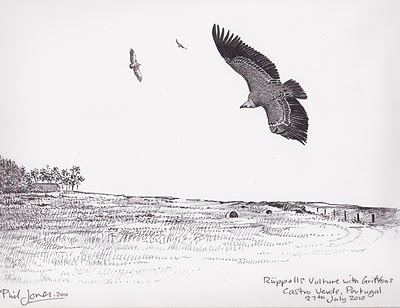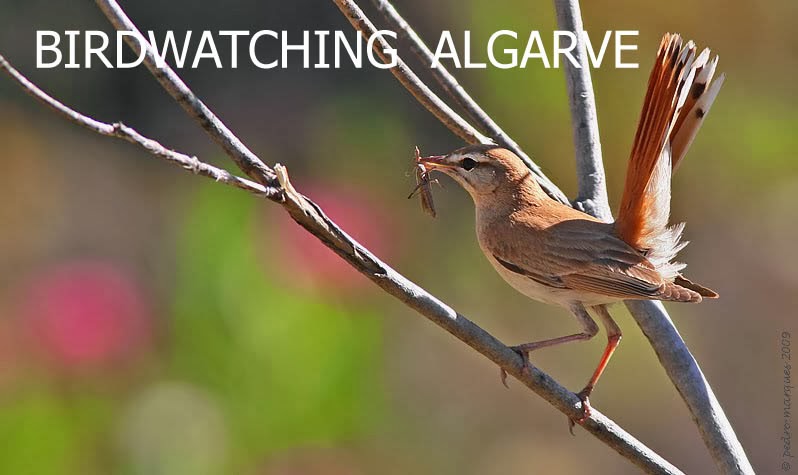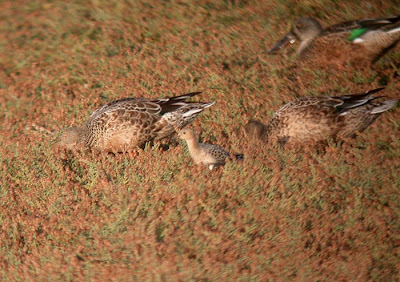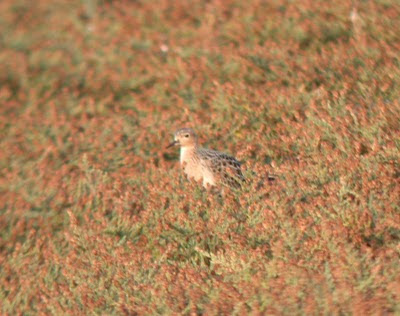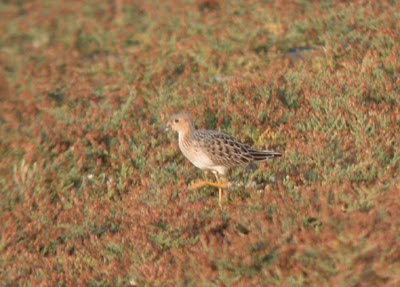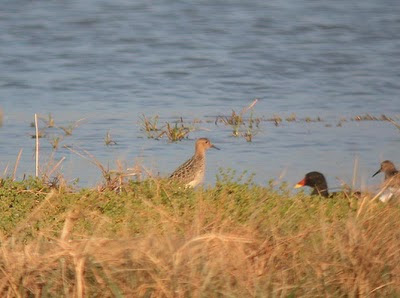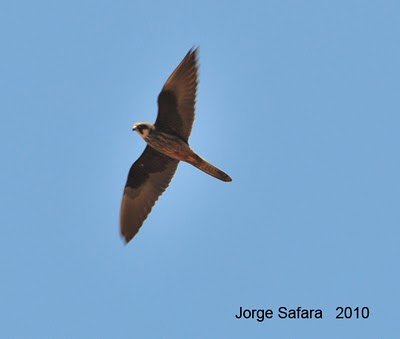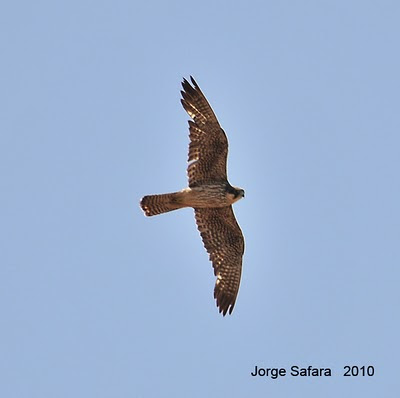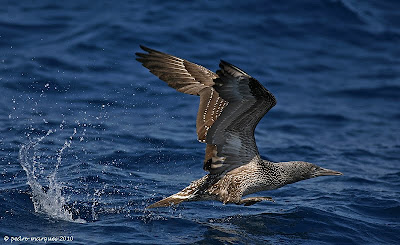 Northern Gannet
Northern Gannet (
Morus bassanus) - juv. taking off next to the boat... (Photo: Pedro Marques) Portimão, 12-09-2010.
Portimão in the West-Algarve has been the starting-point for another Pelagic boat-trip organized - this time together with the company Ecoceanus. Sunday morning, 12th of September 2010, a group of 10 enthusiastic "bird-people" plus 2 people from Ecoceanus met at the marina and at about a quarter to eight we were heading out for about 15 miles straight southwards towards a deep sea-canyon where the marine life is special, because food-rich currents attract a lot of fishes, marine mammals and also marine birds... The 11 m's catamaran is a comfortable boat, which is stable, glides low above the water and offers quite some space to choose and change a place. It has a motor, but sails faster than it drives, when this is necessary. It has been a sunny day with some clouds and a breeze, that caused some waves, but all in all we had very good conditions. Soon the first "Cagarras"/
Cory's Shearwater (
Calonectris diomedea) crossed in front of the boat, gliding in their typical relaxed manner with hanging wings almost touching the surface of the sea and
Northern Gannets (
Morus bassanus) flew parallel to the boat, were flushed by us if they had been swimming, or crossed high over on the way to their fishing-grounds further out. Single
Balearic Shearwaters (
Puffinus mauretanicus) or small groups of three or four of them also passed by, all heading east.
A much lighter, contrasting and less-bellied bird going west was a
Yelkouan Shearwater (
Puffinus yelkouan) and not a
Manx' Shearwater (
Puffinus puffinus) this time... Storm-Petrels were spotted from about four miles onwards - single ones of both species (as far as possible to call them while passing by fast...) and later also small groups - several times of 5 to 10, some of them swimming and then resembling somewhat a flock of Phalaropes... We also came across one or two
Great Skuas (
Stercorarius skua).
At about 10 a.m. we started chumming and within a few minutes, the first Storm-Petrels showed up near the boat,
European Storm Petrels (
Hydrobates pelagicus) in the beginning, but soon also
Wilson's Storm Petrels (
Oceanites oceanicus) and then more and more came...
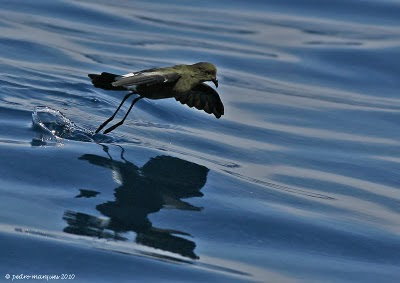 Wilson's Storm Petrel
Wilson's Storm Petrel (
Oceanites oceanicus) by Pedro Marques. Portimão, 12-09-2010.
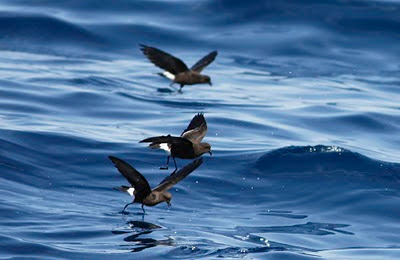 Wilson's Storm Petrels
Wilson's Storm Petrels (
Oceanites oceanicus) by Pim Wolf. Portimão, 12-09-2010.
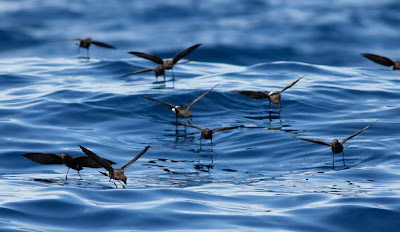 Wilson's Storm Petrels
Wilson's Storm Petrels (
Oceanites oceanicus) by Pim Wolf. Portimão, 12-09-2010.
We had at least 40 to 50 Storm Petrels (of both species together) around the boat during an almost 2 hours chumming session. I have been to a Wilson's Storm Petrel as close as two meters (!) when it came to investigate where all the good smell came from (was me, entirely covered in nice fishy chum ;-). Up to 24 Wilson's were feeding in a flock, resembling big butterflies, when "dancing" upon the water and touching it with their yellow-webbed feet, while picking small food-particles from the surface... These are the situations, when they also call, but this can only be heard with a special equipment. Including the birds we came across along the way, we have seen about 45 to 55 Wilson's Storm Petrels and around 40 to 50 European Storm Petrels during this trip. The following trip-list is based on António Gonçalves' (who just photographed a
Brown Bobby at Portugal's west-coast by the way!) estimates from the (roughly 7 hours) trip:
Puffinus mauretanicus - around 10 Ind.
Puffinus yelkouan - 1 Ind.
Puffinus griseus - 1 Ind.
Calonectris diomedea - 15 to 20 Ind.
Hydrobates pelagicus - around 40 Ind.
Oceanites oceanicus - 45 to 50 Ind.
Morus bassanus - more than 60 Ind.
Larus michahellis and fuscus - around 1000 Ind.
Sterna sandvicencis - 2 Ind.
Sterna hirundo - 7 Ind at Portimão and 2 Ind. at sea
Chlidonias niger - 1 Ind.
Stercorarius skua - 4 to 5 Ind.
Hirundo rustica - 2 small flocks (around 15 Ind.)
Riparia riparia - small groups
Oenanthe oenanthe - 2 inds (1 Ind. landing on the boat)
Sea-mammals:
Minke-Whale (Balaenoptera bonaerensis) - one Ind.
Bottlenose Dolphin (Tursiops truncatus) - a group of around 20
 Wilson's Storm Petrels
Wilson's Storm Petrels (
Oceanites oceanicus) by Pim Wolf. Portimão, 12-09-2010.
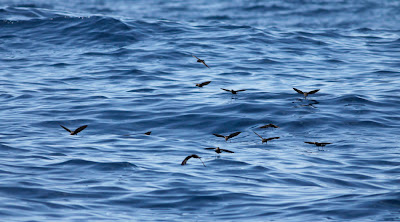 Wilson's Storm Petrels
Wilson's Storm Petrels (
Oceanites oceanicus) by Pim Wolf. Portimão, 12-09-2010.
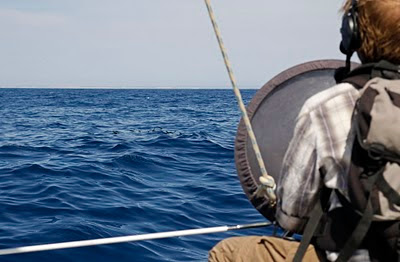
Magnus Robb (
The sound approach to birding) recording a feeding-flock of Wilson's Storm Petrels (Oceanites oceanicus). Photo by Pim Wolf. Portimão, 12-09-2010.
Many thanks to Daniel Machado and Inês from Ecoceanus for an excellent job with the boat and to all who have joined in.
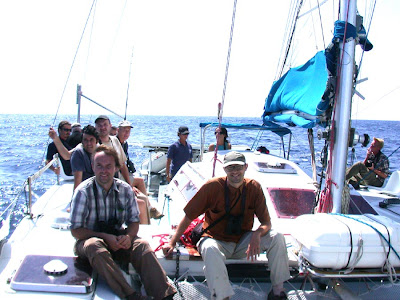
On the way back. Magnus Robb and Luis Godinho in the front, Pim Wolf to the right. Thanks, Pim and Pedro, for sharing your brilliant shots with me (and you) !!!
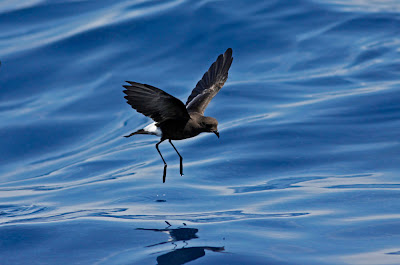 Wilson's Storm Petrel
Wilson's Storm Petrel (
Oceanites oceanicus) by Pim Wolf.
I'd love to repeat a trip like this with Ecoceanus - we only need a group of people to go out (price depending on group-size from 50 € onwards). October is an excellent month for pelagics here, and chances for
Great- and more
Sooty Shearwaters are even higher. Please note also the trips I am organizing together with Passeios Ria Formosa and visit my website
here.
